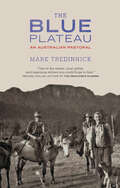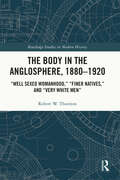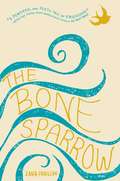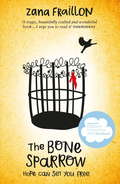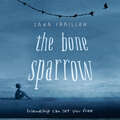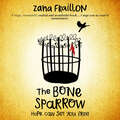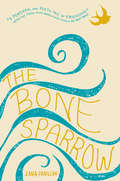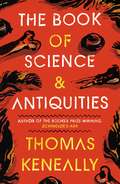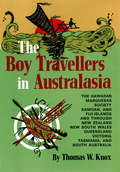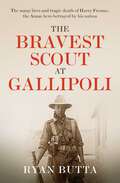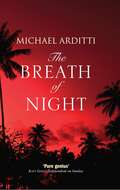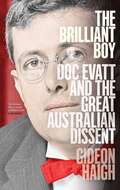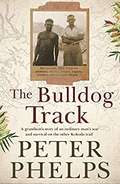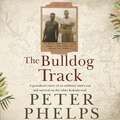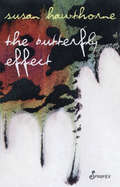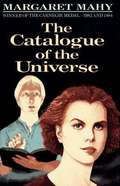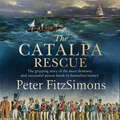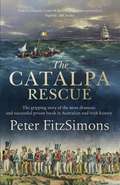- Table View
- List View
The Blue Plateau: An Australian Pastoral
by Mark TredinnickThe author of The Land’s Wild Music depicts Australia’s Blue Mountains through stories of the land and the lives within it.At the farthest extent of Australia’s Blue Mountains, on the threshold of the country’s arid interior, the Blue Plateau reveals the vagaries of a hanging climate: the droughts last longer, the seasons change less, and the wildfires burn hotter and more often. In The Blue Plateau, Mark Tredinnick tries to learn what it means to fall in love with a home that is falling away.A landscape memoir in the richest sense, Tredinnick’s story reveals as much about this contrary collection of canyons and ancient rivers, cow paddocks and wild eucalyptus forests as it does about the myriad generations who struggled to remain in the valley they loved. It captures the essence of a wilderness beyond subjugation, the spirit of a people just barely beyond defeat. Charting a lithology of indigenous presence, faltering settlers, failing ranches, floods, tragedy, and joy that the place constantly warps and erodes, The Blue Plateau reminds us that, though we may change the landscape around us, it works at us inexorably, with wind and water, heat and cold, altering who and what we are.The result is an intimate and illuminating portrayal of tenacity, love, grief, and belonging. In the tradition of James Galvin, William Least Heat-Moon, and Annie Dillard, Tredinnick plumbs the depths of people’s relationship to a world in transition.Praise for The Blue Plateau“One of the wisest, most gifted and ingenious writers you could hope to find.” —Michael Pollan, author of In Defense of Food and The Omnivore’s Dilemma“I’ve never been to Australia, but now—after this book—it comes up in my dreams. The landscape in the language of this work is alive and conscious, and Tredinnick channels it in prose both wild and inspired. . . . Part nonfiction novel, part classic pastoral, part nature elegy, part natural history, the whole of The Blue Plateau conveys a deep sense, rooted in the very syntax of a lush prose about an austere land, that there can be no meaningful division between nature and culture, between humans and all the other life that interdepends with us, not in the backcountry of southeastern Australia, nor anywhere else.” —Orion“Absorbed slowly, as a pastoral landscape of loss and experiment in seeing and listening, the book richly rewards that patience.” —Publishers Weekly
The Body in the Anglosphere, 1880–1920: "Well Sexed Womanhood," "Finer Natives," and "Very White Men" (Routledge Studies in Modern History)
by Robert W. ThurstonFocusing on the body in every chapter, this book examines the changing meanings and profound significance of the physical form among the Anglo-Saxons from 1880 to 1920. They formed an imaginary—but, in many ways, quite real—community that ruled much of the world. Among them, racism became more virulent. To probe the importance of the body, this book brings together for the first time the many areas in which the physical form was newly or more extensively featured, from photography through literature, frontier wars, violent sports, and the global circus. Sex, sexuality, concepts of gender including women’s possibilities in all areas of life, and the meanings of race and of civilization figured regularly in Anglo discussions. Black people challenged racism by presenting their own photos of respectable folk. As all this unfolded, Anglo men and women faced the problem of maintaining civilized control vs. the need to express uninhibited feeling. With these issues in mind, it is evident that the origins of today’s debates about race and gender lie in the late nineteenth century.
The Bone Sparrow
by Zana Fraillon<p>Born in a refugee camp, all Subhi knows of the world is that he's at least 19 fence diamonds high, the nice Jackets never stay long, and at night he dreams that the sea finds its way to his tent, bringing with it unusual treasures. And one day it brings him Jimmie. <p>Carrying a notebook that she's unable to read and wearing a sparrow made out of bone around her neck - both talismans of her family's past and the mother she's lost - Jimmie strikes up an unlikely friendship with Subhi beyond the fence. <p>As he reads aloud the tale of how Jimmie's family came to be, both children discover the importance of their own stories in writing their futures.</p>
The Bone Sparrow
by Zana FraillonWinner of the CILIP Amnesty Honour 2017.Shortlisted for the Guardian Children's Fiction Prize and the CILIP Carnegie Medal 2017.Perfect for fans of THE BOY IN THE STRIPED PYJAMAS. This is a beautiful, vivid and deeply moving story about a refugee boy who has spent his entire life living in a detention centre. This novel reminds us all of the importance of freedom, hope, and the power of a story to speak for anyone who's ever struggled to find a safe home.'...a special book' - Morris Gleitzman, author of the acclaimed ONCE seriesBorn in a refugee camp, all Subhi knows of the world is that he's at least 19 fence diamonds high, the nice Jackets never stay long, and at night he dreams that the sea finds its way to his tent, bringing with it unusual treasures. And one day it brings him Jimmie.Carrying a notebook that she's unable to read and wearing a sparrow made out of bone around her neck - both talismans of her family's past and the mother she's lost - Jimmie strikes up an unlikely friendship with Subhi beyond the fence. As he reads aloud the tale of how Jimmie's family came to be, both children discover the importance of their own stories in writing their futures.
The Bone Sparrow
by Zana FraillonWinner of the CILIP Amnesty Honour 2017.Shortlisted for the Guardian Children's Fiction Prize and the CILIP Carnegie Medal 2017.Perfect for fans of THE BOY IN THE STRIPED PYJAMAS. This is a beautiful, vivid and deeply moving story about a refugee boy who has spent his entire life living in a detention centre. This novel reminds us all of the importance of freedom, hope, and the power of a story to speak for anyone who's ever struggled to find a safe home.'...a special book' - Morris Gleitzman, author of the acclaimed ONCE seriesBorn in a refugee camp, all Subhi knows of the world is that he's at least 19 fence diamonds high, the nice Jackets never stay long, and at night he dreams that the sea finds its way to his tent, bringing with it unusual treasures. And one day it brings him Jimmie.Carrying a notebook that she's unable to read and wearing a sparrow made out of bone around her neck - both talismans of her family's past and the mother she's lost - Jimmie strikes up an unlikely friendship with Subhi beyond the fence. As he reads aloud the tale of how Jimmie's family came to be, both children discover the importance of their own stories in writing their futures.
The Bone Sparrow
by Zana FraillonSometimes, at night, the dirt outside turns into a beautiful ocean. As red as the sun and as deep as the sky. I lie in my bed, Queeny's feet pushing up against my cheek, and listen to the waves lapping at the tent. Subhi is a refugee. Born in an Australian permanent detention centre after his mother fled the violence of a distant homeland, life behind the fences is all he has ever known. But as he grows, his imagination gets bigger too, until it is bursting at the limits of his world. The Night Sea brings him gifts, the faraway whales sing to him, and the birds tell their stories. The most vivid story of all, however, is the one that arrives one night in the form of Jimmie, a scruffy, impatient girl who appears from the other side of the wires, and brings a notebook written by the mother she lost. Unable to read it, she relies on Subhi to unravel her own family's love songs and tragedies. Subhi and Jimmie might both find a way to freedom, as their tales unfold. But not until each of them has been braver than ever before.
The Bone Sparrow
by Zana FraillonWinner of the CILIP Amnesty Honour 2017.Shortlisted for the Guardian Children's Fiction prize 2016.Perfect for fans of The Boy in the Striped Pyjamas. This is a beautiful, vivid and deeply moving story about a refugee boy who has spent his entire life living in a detention centre. This novel reminds us all of the importance of freedom, hope, and the power of a story to speak for anyone who's ever struggled to find a safe home.'...a special book' - Morris Gleitzman, author of the acclaimed ONCE seriesBorn in a refugee camp, all Subhi knows of the world is that he's at least 19 fence diamonds high, the nice Jackets never stay long, and at night he dreams that the sea finds its way to his tent, bringing with it unusual treasures. And one day it brings him Jimmie.Carrying a notebook that she's unable to read and wearing a sparrow made out of bone around her neck - both talismans of her family's past and the mother she's lost - Jimmie strikes up an unlikely friendship with Subhi beyond the fence. As he reads aloud the tale of how Jimmie's family came to be, both children discover the importance of their own stories in writing their futures.(P) Orion Children's Group 2016
The Bone Sparrow
by Zana Fraillon"Indispensable."-Booklist (starred review) CARNEGIE MEDAL 2017 FINALISTSubhi is a refugee. He was born in an Australian permanent detention center after his mother and sister fled the violence of a distant homeland, and the center is the only world he knows. But every night, the faraway whales sing to him, the birds tell him their stories, and the magical Night Sea from his mother's stories brings him gifts. As Subhi grows, his imagination threatens to burst beyond the limits of the fences that contain him. Until one night, it seems to do just that. Subhi sees a scruffy girl on the other side of the wire mesh, a girl named Jimmie, who appears with a notebook written by the mother she lost. Unable to read it herself, Jimmie asks Subhi to unravel her family's love songs and tragedies that are penned there. Subhi and Jimmie might both find comfort-and maybe even freedom-as their tales unfold. But not until each has been braver than ever before and made choices that could change everything.
The Book of Science and Antiquities
by Thomas KeneallyA novel of breath-taking reach and inspired imagination, drawing on the discovery of Australia's oldest known human inhabitant. Shade lives peaceably with his second wife on the shores of a bountiful lake. Conscious of ageing but still vigorous, when called on by the spirit ancestors to sacrifice himself for the sake of his clan, he knows he must obey. Over 40,000 years later, Shade's skeleton is unearthed near the now dry Lake Learned in New South Wales. The sensational discovery of so-called 'Learned Man' rewrites the history of Australia and fuels the Aboriginal people's claim to be the land's rightful owners - and has a lasting impact on a young documentary maker, Shelby Apple, who gets caught up in the fate of Learned's remains. When Shelby, too, faces mortality and looks back on his life, Learned stands as an enduring spirit, a fellow player in the long, ever-evolving story of humankind.
The Book of Science and Antiquities
by Thomas KeneallyIn a novel of breathtaking reach and inspired imagination, the Booker Prize-winning author of Schindler's Ark tells the stories of two men who have much in common. What separates them is 42,000 years.Shade lives with his second wife amid their clan on the shores of a bountiful lake. A peaceable man, he knows that when danger threatens, the Hero ancestors will call on him to kill, or sacrifice himself, to save his people.Over 40,000 years later, Shade's remains are unearthed near the now dry Lake Learned in New South Wales. The sensational discovery fascinates Shelby Apple, a documentary film maker who tracks the controversies it provokes about who the continent's first inhabitants were and where Shade's bones belong.Shelby goes on to follow his own heroes to the battlefields of Eritrea and the Rift Valley where Homo sapiens sprang from. When he, too, faces mortality and looks back on his passions, ideals and sorely tested marriage, Learned Man stands as an enduring spirit, a fellow player in the long, ever-evolving story of humankind.
The Boy Travellers in Australasia
by Thomas W. KnoxHere is humor, especially in many of the illustrations; nostalgia and escapism. The author was one of the most colorful and popular figures on the New York scene at the height of his career in the 1880's. This fine book is just one of his many legacies, and is an invaluable contribution toward a better understanding of our fine friends Down Under.
The Boy Travellers in Australasia
by Thomas W. KnoxHere is humor, especially in many of the illustrations; nostalgia and escapism. The author was one of the most colorful and popular figures on the New York scene at the height of his career in the 1880's. This fine book is just one of his many legacies, and is an invaluable contribution toward a better understanding of our fine friends Down Under.
The Bravest Scout at Gallipoli: The many lives and tragic death of Harry Freame, the Anzac hero betrayed by his nation
by Ryan ButtaHarry Freame was the first Australian to win the Distinguished Conduct Medal at Gallipoli. Raised as a samurai, he risked his life again and again to scout the beaches and hills of the battlefield, reporting invaluable intelligence back to his officers and relieving stranded soldiers who otherwise would surely have died. Some say he should have got the VC but didn't because he was half-Japanese, a fact he tried hard to conceal.After the war, Harry (real name Henry Wykeham Koba Freame) became a soldier settler and champion apple grower. But when Japan emerged as a perceived threat to Australia, Harry was recruited into Australian intelligence to spy on the Japanese community in Sydney. Before Japan's entry into World War II, Australia opened a diplomatic legation in Tokyo, and Harry was sent as a translator - but his real role was a spy. Extraordinarily, his cover was leaked by the Australian press, and the Japanese secret police tried to assassinate him not long after his arrival in Tokyo in 1941. Harry died back in Australia a few weeks later, but his sacrifice has never been acknowledged by Australia.Until now. Featuring never-before-seen material, The Bravest Scout at Gallipoli is a fascinating and immersive investigation into a grievous historical wrong.
The Bravest Scout at Gallipoli: The many lives and tragic death of Harry Freame, the Anzac hero betrayed by his nation
by Ryan ButtaHarry Freame was the first Australian to win the Distinguished Conduct Medal at Gallipoli. Raised as a samurai, he risked his life again and again to scout the beaches and hills of the battlefield, reporting invaluable intelligence back to his officers and relieving stranded soldiers who otherwise would surely have died. Some say he should have got the VC but didn't because he was half-Japanese, a fact he tried hard to conceal.After the war, Harry (real name Henry Wykeham Koba Freame) became a soldier settler and champion apple grower. But when Japan emerged as a perceived threat to Australia, Harry was recruited into Australian intelligence to spy on the Japanese community in Sydney. Before Japan's entry into World War II, Australia opened a diplomatic legation in Tokyo, and Harry was sent as a translator - but his real role was a spy. Extraordinarily, his cover was leaked by the Australian press, and the Japanese secret police tried to assassinate him not long after his arrival in Tokyo in 1941. Harry died back in Australia a few weeks later, but his sacrifice has never been acknowledged by Australia.Until now. Featuring never-before-seen material, The Bravest Scout at Gallipoli is a fascinating and immersive investigation into a grievous historical wrong.
The Breath of Night
by Michael ArdittiPhilip Seward travels to the Philippines to investigate the case of a missionary priest imprisoned for murder, where he is drawn into a labyrinth of vice, violence, and corruption where nothing and nobody are what they seem.'Part Conrad, part Waugh, part Greene, and pure genius' Independent on Sunday'This is Arditti's most dazzling novel to date because of the scale of his ambition and his triumph in pulling it off' Peter Stanford, Daily TelegraphWhile working as a missionary priest in the Philippines during the Marcos dictatorship, Julian Tremayne championed the Communist rebels and found himself imprisoned for murder. Now, three decades later, following Julian's death, a cult develops around him, even calling for sainthood. When Philip Seward goes to investigate on behalf of Julian's family, he is drawn into a labyrinth of vice, violence, and corruption where nothing and nobody are what they seem. Enriched by a gallery of engaging characters ranging from priests to prostitutes, GIs to gangsters, and street children to Imelda Marcos, this outstanding novel is at once a gripping psychological thriller, a challenging moral mystery, and an unforgettable voyage into a dark and exotic landscape.
The Brilliant Boy: Doc Evatt and the Great Australian Dissent
by Gideon HaighIn a quiet Sydney street in 1937, a seven year-old immigrant boy drowned in a ditch that had filled with rain after being left unfenced by council workers. How the law should deal with the trauma of the family&’s loss was one of the most complex and controversial cases to reach Australia&’s High Court, where it seized the imagination of its youngest and cleverest member. These days, &‘Doc&’ Evatt is remembered mainly as the hapless and divisive opposition leader during the long ascendancy of his great rival Sir Robert Menzies. Yet long before we spoke of &‘public intellectuals&’, Evatt was one: a dashing advocate, an inspired jurist, an outspoken opinion maker, one of our first popular historians and the nation&’s foremost champion of modern art. Through Evatt&’s innovative and empathic decision in Chester v the Council of Waverley Municipality, which argued for the law to acknowledge inner suffering as it did physical injury, Gideon Haigh rediscovers the most brilliant Australian of his day, a patriot with a vision of his country charting its own path and being its own example – the same attitude he brought to being the only Australian president of the UN General Assembly, and instrumental in the foundation of Israel. A feat of remarkable historical perception, deep research and masterful storytelling, The Brilliant Boy confirms Gideon Haigh as one of our finest writers of non-fiction. It shows Australia in a rare light, as a genuinely clever country prepared to contest big ideas and face the future confidently. 'Here is a master craftsman delivering one of his most finely honed works. Meticulous in its research, humane in its storytelling, The Brilliant Boy is Gideon Haigh at his lush, luminous best. Haigh shines a light on person, place and era with the sheer force of his intellect and the generosity of his words. The Brilliant Boy is simply a brilliant book.' Clare Wright, Stella-Prize winning author of The Forgotten Rebels of Eureka 'Gideon Haigh is one of Australia&’s most versatile and skilled historians.' Geoffrey Blainey 'This new biography of HV Evatt lifts the lid on his early life as a brilliant barrister and creative Justice of the High Court of Australia. It reveals the wellsprings that gave birth to his humanitarian and internationalist values that later helped in the creation of the United Nations. It helps to explain Evatt's valiant defence of liberty in fighting off the attempt to ban the communists in Australia. We need to constantly renew our acquaintance with such values. This book reminds us of Evatt's flawed genius but deep motivations, lest we ever forget.' The Hon Michael Kirby AC CMG
The Bulldog Track: A grandson's story of an ordinary man's war and survival on the other Kokoda trail
by Peter PhelpsThis is the story of Tom Phelps and the 'other Kokoda Track'. Seventy-five years later, Tom's grandson, award-winning actor and writer Peter Phelps, is sharing this inspiring tale of resilience and survival.March 1942: The world is at war. Too old to fight and with jobs scarce at home, Tom Phelps found work as a carpenter in the goldfields of the New Guinea Highlands. No one expected the Japanese to attack in the Pacific. But they did.Tom and his mates weren't going to hang around and wait to be killed. With escape routes bombed by the Japanese, their only option was to try to reach safety by foot, through some of the most rugged terrain on Earth - the Bulldog Track.Back home in Sydney, Rose Phelps, their son, George, and three daughters, Joy, Shirley and Ann, waited for news of Tom's fate. George watched the horrors of war unfold on newsreels knowing his dad was 'over there'.Travelling by foot, raft, canoe, schooner, train, luck and courage, Tom Phelps, half-starved and suffering malaria, would eventually make it home. His stories of New Guinea would lead his son and grandson to their own experiences with the country. The Bulldog Track is a grandson's story of an ordinary man's war. It is an incredible tale of survival and the indomitable Aussie spirit.
The Bulldog Track: A grandson's story of an ordinary man's war and survival on the other Kokoda trail
by Peter PhelpsThis is the story of Tom Phelps and the 'other Kokoda Track'. Seventy-five years later, Tom's grandson, award-winning actor and writer Peter Phelps, is sharing this inspiring tale of resilience and survival.March 1942: The world is at war. Too old to fight and with jobs scarce at home, Tom Phelps found work as a carpenter in the goldfields of the New Guinea Highlands. No one expected the Japanese to attack in the Pacific. But they did.Tom and his mates weren't going to hang around and wait to be killed. With escape routes bombed by the Japanese, their only option was to try to reach safety by foot, through some of the most rugged terrain on Earth - the Bulldog Track.Back home in Sydney, Rose Phelps, their son, George, and three daughters, Joy, Shirley and Ann, waited for news of Tom's fate. George watched the horrors of war unfold on newsreels knowing his dad was 'over there'.Travelling by foot, raft, canoe, schooner, train, luck and courage, Tom Phelps, half-starved and suffering malaria, would eventually make it home. His stories of New Guinea would lead his son and grandson to their own experiences with the country. The Bulldog Track is a grandson's story of an ordinary man's war. It is an incredible tale of survival and the indomitable Aussie spirit.
The Butterfly Effect
by Susan HawthorneThe flap of a butterfly's wing in one part of the world can cause devastating storms on the other side, just as the word "lesbian"--a force full of vitality and world-changing creativity--can destroy families and bring down governments. Evoking the ancient worlds of pre-Vedic and Sapphic lovers, medieval jonglaresas, and nuns "fingering petals and hips," as well as the contemporary world of circuses, global politics, friendship, betrayal, and death, the poems in this collection fold in on themselves, exploding into concentric rings of meaning, rich in symbol and metaphor.
The Cambridge Companion to Australian Literature
by Elizabeth WebbyThis book introduces in a lively and succinct way the major writers, literary movements, styles and genres that, at the beginning of a new century, are seen as constituting the field of Australian literature. The book consciously takes a perspective that sees literary works not as aesthetic objects created in isolation by unique individuals, but as cultural products influenced and constrained by the social, political and economic circumstances of their times. It will be an indispensable reference for both national and international readers. It covers Indigenous texts, colonial writing and reading, poetry, fiction and theater throughout two centuries, biography and autobiography, and literary criticism in Australia.
The Cambridge Companion to Kafka
by Julian PreeceFranz Kafka's writing has had a wide-reaching influence on European literature, culture and thought. The Cambridge Companion to Kafka, offers a comprehensive account of his life and work, providing a rounded contemporary appraisal of Central Europe's most distinctive Modernist. Contributions cover all the key texts, and discuss Kafka's writing in a variety of critical contexts such as feminism, deconstruction, psycho-analysis, Marxism, Jewish studies. Other chapters discuss his impact on popular culture and film. The essays are well supported by supplementary material including a chronology of the period and detailed guides to further reading, and will be of interest to students of German, European and Comparative Literature, Jewish Studies.
The Catalogue of the Universe
by Margaret MahyConfident Angela and intellectual Tycho seem an unlikely pair. They share a passion for deciphering the universe outside their own personal struggles. To Angela and Tycho, it seems the universe can be ordered; their own lives cannot. As their family struggles swirl around them, they are suddenly desperate to discover where they fit in.
The Catalpa Rescue: The gripping story of the most dramatic and successful prison break in Australian history
by Peter FitzSimonsThe incredible true story of one of the most extraordinary and inspirational prison breaks in Australian history.New York, 1874. Members of the Clan-na-Gael - agitators for Irish freedom from the English yoke - hatch a daring plan to free six Irish political prisoners from the most remote prison in the British Empire, Fremantle Prison in Western Australia. Under the guise of a whale hunt, Captain Anthony sets sail on the Catalpa to rescue the men from the stone walls of this hell on Earth known to the inmates as a 'living tomb'. What follows is one of history's most stirring sagas that splices Irish, American, British and Australian history together in its climactic moment.For Ireland, who had suffered English occupation for 700 years, a successful escape was an inspirational call to arms. For America, it was a chance to slap back at Britain for their support of the South in the Civil War; for England, a humiliation. And for a young Australia, still not sure if it was Great Britain in the South Seas or worthy of being an independent country in its own right, it was proof that Great Britain was not unbeatable. Told with FitzSimons' trademark combination of arresting history and storytelling verve, The Catalpa Rescue is a tale of courage and cunning, the fight for independence and the triumph of good men, against all odds.
The Catalpa Rescue: The gripping story of the most dramatic and successful prison break in Australian history
by Peter FitzSimonsThe incredible true story of one of the most extraordinary and inspirational prison breaks in Australian history.New York, 1874. Members of the Clan-na-Gael - agitators for Irish freedom from the English yoke - hatch a daring plan to free six Irish political prisoners from the most remote prison in the British Empire, Fremantle Prison in Western Australia. Under the guise of a whale hunt, Captain Anthony sets sail on the Catalpa to rescue the men from the stone walls of this hell on Earth known to the inmates as a 'living tomb'. What follows is one of history's most stirring sagas that splices Irish, American, British and Australian history together in its climactic moment.For Ireland, who had suffered English occupation for 700 years, a successful escape was an inspirational call to arms. For America, it was a chance to slap back at Britain for their support of the South in the Civil War; for England, a humiliation. And for a young Australia, still not sure if it was Great Britain in the South Seas or worthy of being an independent country in its own right, it was proof that Great Britain was not unbeatable. Told with FitzSimons' trademark combination of arresting history and storytelling verve, The Catalpa Rescue is a tale of courage and cunning, the fight for independence and the triumph of good men, against all odds.
The Catalpa Rescue: The gripping story of the most dramatic and successful prison story in Australian and Irish history
by Peter FitzSimonsThe incredible true story of one of the most extraordinary and inspirational prison breaks in Australian history.New York, 1874. Members of the Clan-na-Gael - agitators for Irish freedom from the English yoke - hatch a daring plan to free six Irish political prisoners from the most remote prison in the British Empire, Fremantle Prison in Western Australia. Under the guise of a whale hunt, Captain Anthony sets sail on the Catalpa to rescue the men from the stone walls of this hell on Earth known to the inmates as a 'living tomb'. What follows is one of history's most stirring sagas that splices Irish, American, British and Australian history together in its climactic moment.For Ireland, who had suffered English occupation for 700 years, a successful escape was an inspirational call to arms. For America, it was a chance to slap back at Britain for their support of the South in the Civil War; for England, a humiliation. And for a young Australia, still not sure if it was Great Britain in the South Seas or worthy of being an independent country in its own right, it was proof that Great Britain was not unbeatable.Told with FitzSimons' trademark combination of arresting history and storytelling verve, The Catalpa Rescue is a tale of courage and cunning, the fight for independence and the triumph of good men, against all odds.
